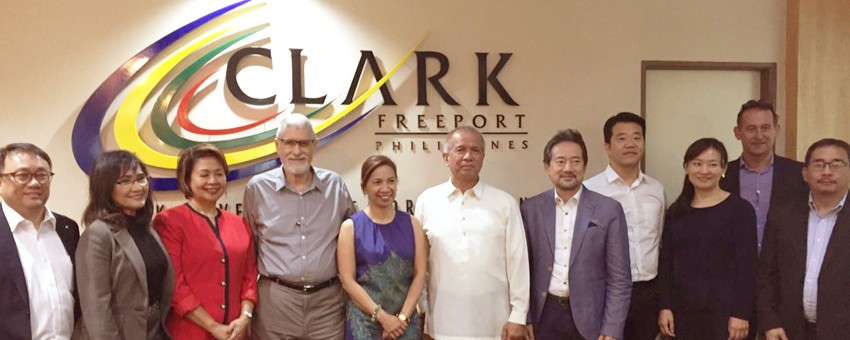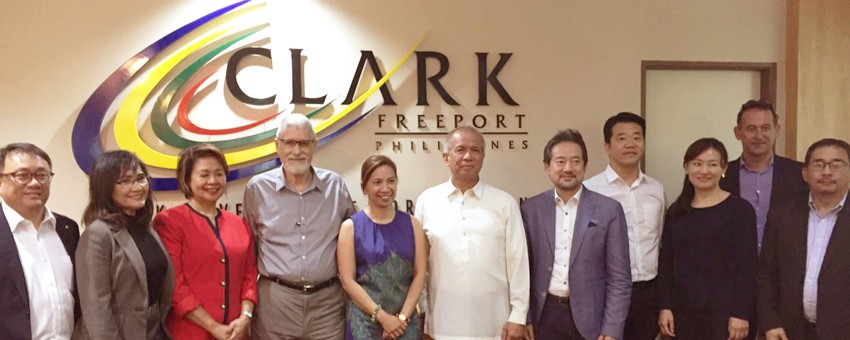
(L-R): AmCham 2nd Vice President, Manufacturing Committee Chairman, and Dow Chemical Country Director Roberto Batungbacal, Subic-Clark Alliance for Development Executive Director Erlinda Pamintuan, CanCham Executive Director Cora dela Cruz, AmCham-TAPP Senior Adviser John D. Forbes, CDC Vice-President for Business Development and Business Enhancement Group Eva G. Tejada, Semiconductor and Electronics Industries in the Philippines Foundation, Inc. (SEIPI) President Dr. Danilo C. Lachica, KCCP President Ho Ik Lee, KCCP Director Joo Won Kim, KCCP Director Julia Lee, ANZCham Member Brett McPhee, ECCP Manager for Project and Partnerships Archie H. Diaz. (Not Pictured) Bases Conversion and Development Authority (BCDA) Engr. Ryan Pineda, BCDA Engr. Brando Aguilea, AmCham-TAPP Advocacy and Research Specialist Jannica Anne Gaisano, Dow Chemical Business Development Leader Errol R. Ignacio. SEIPI Business Lead and ManCom Mabelle de la Cruz, SEIPI Senior Analyst Lezlie Batarao, and SEIPI Analyst Jan Abejero.
- Agenda
- Introduction of Joint Foreign Chambers and Arangkada
- Priorities of CDC
- Clark Green City
- Commuter and fast-train connections to Manila
- Photo Opportunity
- Points of Discussion
- Introduction of the Joint Foreign Chambers
- Mr. Forbes introduced the JFC, noting that they collectively account for 2,500 members involved in an estimated $80 billion trade and $30 billion investments.
- Mr. Batungbacal introduced himself as Vice President of AmCham and lead of manufacturing committee. He is country head of DOW Chemical.
- Mr. Ho-Ik Lee from KCCP noted that there are many Korean businesses in Clark today, including Phoenix Semiconductor Philippines Corporation (a Samsung subsidiary).
- Mr. Forbes handed over JFC’s documents on its advocacies about the country’s investment climate. He mentioned that there is an Airport policy brief which advocates for a new terminal to be built in Clark to expand capacity. With many other partners and good governance in the last administration, the level of the country’s FDI went up by 641% to $7.9 billion in 2016.
- Updates on the CDC Developments
- Clark wants to position itself to be a major logistics hub within the Asia Pacific, centering on the tourism service area. It thrives on ICT, tourism, manufacturing, and aviation-related industries.
- The Clark Freeport and Special Economic Zone (CFEZ) has a total of 31, 400 hectares
- Special Economic Zone has 27,000 hectares – where Clark Green City will be established
- Freeport Zone has 4,400 hectares
- Airport area has 2,300 hectares
- Mixed-use area has 2,100 hectares
- CDC manages the whole zone. In the airport area, the airport authority leases the land. All the regulatory functions required from a locator are being handled and regulated by CDC. Clark Freeport Zone (CFZ) has 900 locators. The breakdown per industry is as follows:
- CFZ has an estimated 102,000 workers today. As a comparison, Clark had 15,000 Filipino workers during the time of Clark Air Base. The issue during the eruption of Mt. Pinatubo and the departure of the US military is the fear that Filipinos will lose their jobs. Subic had 35,000 then and they have around 102,000 to 105,000 today. (Note: These figures do not count Filipinos employed by US military families living outside the bases.)
- CFZ exported $3.32B worth of goods in 2016, with Phoenix Semiconductor accounting for 51% of total exports. Exports of Texas Instruments are not included in the $3.32b figure because it is a PEZA locator. Top exporters in Clark are as follows:
| TI |
$1.8billion |
| PSPC |
$1.6b |
| Nanox Phil. |
$772M |
| Yokohama |
$273M |
- CFZ’s revenue in 2016 was Php 1.64 billion and net income Php 0.78 billion.
- The Clark International Airport has 204 flights a week – 146 international and 58 domestic. Airlines include Emirates, Qatar Airways, Asiana Airlines, Cebu Pacific, Dragon Air, Jin Air, TigerAir, PAL, and AirAsia.
- Clark is becoming a favorite tourism destination for sports activities, including the hot air balloon festival, running, racing, frisbee, and football. It was ranked 8th by the DOT as a tourism destination in 2015 and it has also been the sports destination of the year. Clark is also a destination for international events. It was the venue of the APEC Senior Officials Meeting in 2015 and it will be the venue for the ASEAN Summit meeting with ten non-ASEAN heads of state in November 2017.
- CFZ Industrial developments
- Phoenix Semiconductor’s expansion will increase their workers from 1,600 to 3,000; capacity will be doubled from $1.6 billion to $3 billion. It is a $170 million investment for the expansion.
- Nanox Philippines is Japan Display Inc. in Japan which manufactures LED products. From less than 1 hectare, they expanded by another 6 hectares; from 2,300 workers, they have 9,000 workers.
- TI just finished its new product distribution center, which is a state-of-the-art storage retrieval system.
- Ms. Tejada mentioned that outbound promotion missions this year include Japan, Australia, Europe, Korea, and China. They deferred their mission to the US to wait for the pronouncement of President Trump on issues like TPP and the call center business.
- CFZ has a 25-hectare power facility generating 22MW.
- The 2017 budget for the infrastructure development for Clark is P1.2 billion.
Infrastructure developments include the following:
- Hotels – establishment of Marriott Clark by Widus Hotel and Casino, New Hotel Clark by Royce Hotel and Casino, Hilton Hotel by Sun Valley Clark by Korean firm Dong Huang, New Township (Mimosa) by Filinvest, Aqua Planet (theme park development), and Clark Zoo beside Aqua Plane. Holiday Hotel was turned over to Quest Hotel. Clark currently has 1,600 hotel rooms that will reach 3,000 rooms with the new hotels.
- Dr. Lachica asked how many casinos Clark has. Ms. Eva noted Clark has four casinos, namely Widus, Royce, Mimosa, and Midori. One is PAGCOR-operated while three have licenses from PAGCOR. Ms. Eva noted that the policy of PAGCOR is to limit casinos at Clark to a maximum of six to seven.
- Commercial spaces – a lot of commercial spaces and infrastructure are also being built. Clark Global is building five LEED office buildings.
- New roads – a new 6km road parallel to the national highway will help decongest McArthur Highway
- Revalidation of the Clark Master Plan, to align with the planned developments of the government.
- Only 40 hectares of scattered land are available for lease. The largest is 10-11 hectares.
- Utilities plan – World Bank-IFC offered to do the integrated transport study.
- Integrated transport study – Uber and Grab do not operate here. LTFRB and Sec. Tugade do not approve if they do not accept liability
- Bicycle lanes will be implemented after expanding the roads
- CDC rebranding with tagline “Everything Clark”
- Projects of the Duterte government for Clark
- Manila-Clark Railway – guaranteed 1 hour from Metro Manila to Clark International Airport. It is a P97B North-South Commuter Rail project with the help of Japanese government. Target date of completion is 2021.
- Subic-Clark Cargo Railway Project – target completion with the help of the Chinese government is by 2020.
- Clark International Airport new terminal building – 8 million per annum capacity; target completion by 2019.
- Clark Green City – a 9,450 hectare smart, green, and disaster-resilient city.
- The Clark Green City
- It is a comprehensive development plan led by the BCDA.It is a 9450-hectares master-planned metropolis that is flood proof, disaster resilient, environment friendly, and has integrated urban development.
- For road network, it is planned to establish a road directly linked to Clark Airport. Bike lanes will be established within the Green City.
- Clark is envisioned to be the Philippine sports city. It is where the upcoming SEA games can be held should the Philippines host the event.
- Clark Green City can be the site of new government center. A one-stop shop for all government requirements is envisioned to be established in the city.
- For pioneer developments, the following are planned to be established within the city.
- Educational institutions including University of the Philippines, Philippine Science High School, and Technological University of the Philippines
- Government institutions
- Integrated transport system is to be completed by 2019

